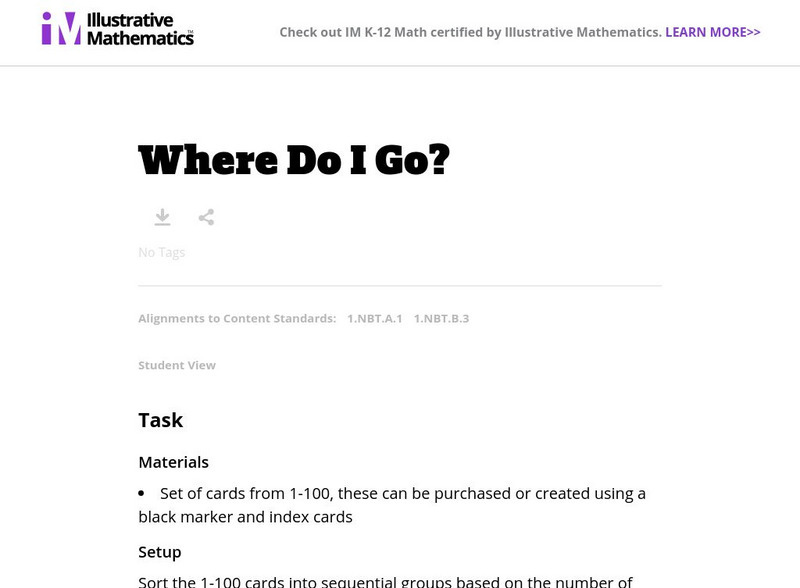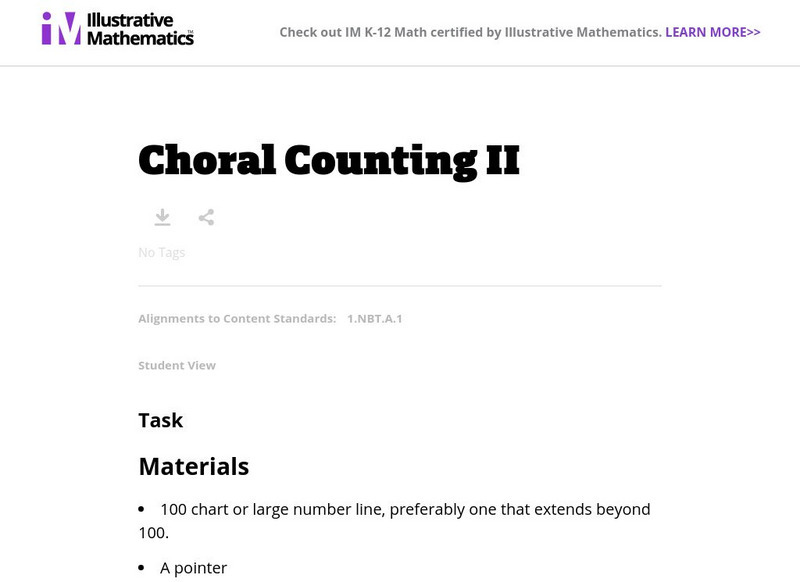Illustrative Mathematics
Illustrative Mathematics: Start/stop Counting Ii
Learners will practice counting to 120 forward and backward with this whole class game. The teacher will give a counting sequence (for example, 20-120) to the students who will be seated in a circle. The teacher will begin walking around...
Illustrative Mathematics
Illustrative Mathematics: Hundred Chart Digit Game
Students will practice identifying two-digit numbers with this game which utilizes a 100 chart. Instructions, materials needed, and variations are included in this lesson.
Illustrative Mathematics
Illustrative Mathematics: Crossing the Decade" Concentration
This game is a version of the traditional memory or concentration game and will help students practice "crossing the decade". A detailed explanation of the rules, materials needed, and variations are included in this lesson.
Illustrative Mathematics
Illustrative Mathematics: Where Do I Go?
Learners will get a chance to move around while practicing number sequences. Teachers will pre-make or buy cards numbered to 100. Give each student a card and have them move around and arrange themselves in sequential order. Multiple...
Illustrative Mathematics
Illustrative Mathematics: Number of the Day
Repeatable, daily activities are one of the best ways to instill the counting sequence for children. This activity requires a 100 chart which can be made or purchased. Students will count the "Number of the Day" beginning with 1 on the...
Illustrative Mathematics
Illustrative Mathematics: Choral Counting Ii
Using a 100 chart, students will chant the counting sequence starting with one to one hundred. Variations can include skip counting, counting from various numbers other than one, and counting backward.
Better Lesson
Better Lesson: Filling the Shadow
Variety is the spice of life and the concept of the day as students fill the same pattern block outline three different ways.
Better Lesson
Better Lesson: "Time" for My Catch
The day has come for students to create their own fish and to make sure that it is a keeper. The students will also be introduced to the clock face and the idea of hour notation.
Better Lesson
Better Lesson: 20 Beans
Through a counting game called 20 Beans, 1st graders count a set of objects up to 20, starting at any number less than 20.
Better Lesson
Better Lesson: Popcorn
SWBAT explore the characteristics of cubes, pattern blocks, and geometry blocks. SWBAT count a set of objects up to 20 by 1's. SWBAT play the game "Greater Than" with a partner, using the correct vocabulary.
Better Lesson
Better Lesson: What Is Today?
SWBAT identify the name of the month, number of the day, and number of the year on a calendar. SWBAT explore math tools, and will demonstrate their ability to count 20 objects.
Better Lesson
Better Lesson: Spatial Patterns for Numbers 10 Through 15
SWBAT use a ten frame to build and identify the numbers 10 through 15.
Better Lesson
Better Lesson: Spatial Patterns for 0 5
SWBAT match dot patterns and ten frame patterns to their appropriate number.
Better Lesson
Better Lesson: Number Puzzles
SWBAT apply their understanding of patterns on the hundreds chart and the counting sequence to create a number chart.
Better Lesson
Better Lesson: Missing Numbers
SWBAT identify patterns on a hundreds chart. SWBAT use patterns and structure of the hundreds chart to identify missing numbers.
Better Lesson
Better Lesson: Introducing a Number Line
SWBAT place numerals in order from least to greatest on a number line.
Better Lesson
Better Lesson: Patterns for Numerals 6 10
SWBAT count to ten and identify numbers by counting object patterns.
Better Lesson
Better Lesson: Kicking Off the Year With Counting
SWBAT match a numeral with its written digit form for numbers below 20 and learn the meaning of digit and numeral.
Better Lesson
Better Lesson: Missing Numbers to 50
SWBAT use patterns on a 50 chart to identify missing numbers.
Better Lesson
Better Lesson: Wanted: Runaway Number
SWBAT describe numbers using base ten language, models and number charts.
Better Lesson
Better Lesson: How Are They Different?
SWBAT order a set of numbers and quantities up to 12 and compare two quantities up to 10 to see which one is greater. The students will also demonstrate their knowledge of how the numbers in the counting sequence are related (that each...
Better Lesson
Better Lesson: How Many in Your Box?
SWBAT make a connection between number names and written numbers to the quantities they represent. They will also practice ordering numbers and quantities up to 12. Students will also document a solution to a problem








